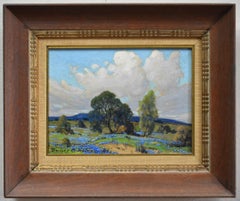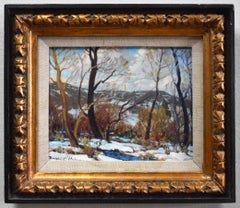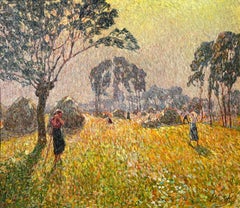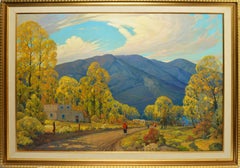Dwight Holmes Art
Dwight C. Holmes, known for ornamental architectural sculpting as well as painting and etching, was born in Albany, Oregon, in 1900. He began formal art training at the Ball High School in Galveston; studied five years in the Texas Christian University, serving also as a student assistant and art editor for the College annual. He received his Certificate of Art and Bachelor of Arts degree and became a faculty member in the Art Department. He left teaching to serve a five-year apprenticeship to achieve membership in Modelers and Sculptors of America. He studied with George Franz of Germany and Michael Lengyl of Austria. He has done ornamental architectural sculpting over 40 years and enjoys a broad art horizon that includes sculpting, painting, designing, ceramics, carving, gold-leafing, restoration, etc. He paints in any medium and any subject matter but prefers oils and landscapes. He studied at the Texas Christian University with Mary Sue Darter Coleman, Mrs. R. E. Cockerell, Sam P. Ziegler, and others. In California, he studied with George Flowers, at the Art Institute in Pasadena, and in workshops with Lee McCarthy, Leonard Boreman, and etching with Bernard Wall. He held membership in the Painters' Club and Fort Worth Art Association; the American Federation of Art; the River Art Group and Coppini Academy of Fine Arts in San Antonio; the Southwest Ceramic Society; the San Angelo Art Club and Arts Council, and others. Dwight Holmes began winning art awards at age 13 and has continued receiving numerous honors and awards over the years. He held art exhibits all over the Southwest, from Florida to California. His works have been shown in Boston, Cleveland, New York, Kansas City, Columbia, Missouri and elsewhere. He has painted along the Gulf, East and West Coasts; throughout Texas; in Mexico, New Mexico, Arizona, Utah, Colorado, California, Tennessee, Georgia, in the Great Smokies, Yellowstone, Grand Tetons, Red Rock Country, Hawaii, etc. He maintained a studio at 2401 Sherwood Way, San Angelo, Texas, but enjoys doing much of his painting out on locations, His interests included juror for shows; giving criticisms and appraisals, and conducting art workshops and art colonies. In addition to museums works by Dwight C. Holmes may be seen in many private collections including Mr. Levi Cole, banker, Canyon, Texas; Dr. A. McChesney, M.D., Columbia, Missouri; S. Herbert Hare, former President Nat'l Association Landscapes Architects; Mr. Scott, Quaker Oats Co; Mr. Moore, Anheuser Busch Co, New Orleans, Cecil Kangaroo, Insurance, Ft. Worth, James Buchanan Architect, Ft. Worth, and others. Several books have been published which give short histories of outstanding artists of Texas, in which Dwight C. Holmes is included: A History of Texas Artists and Sculptors by Fisk; Art and Artists of Texas by O'Brien; Art on the Texas Plains by Elsie M. Wilbanks. The following, also from Bill Cheek, is from the back of a signed Holmes print and personal communications of Raul Ruiz, a San Angelo artist and student of Holmes.
1970s Impressionist Dwight Holmes Art
Oil
1960s Impressionist Dwight Holmes Art
Oil
20th Century Impressionist Dwight Holmes Art
Oil
1980s American Impressionist Dwight Holmes Art
Oil
20th Century Dwight Holmes Art
Oil, Canvas
1980s Impressionist Dwight Holmes Art
Oil
20th Century Dwight Holmes Art
Canvas, Oil
1910s American Impressionist Dwight Holmes Art
Canvas, Oil
Early 20th Century Impressionist Dwight Holmes Art
Canvas, Oil
20th Century American Impressionist Dwight Holmes Art
Oil, Canvas
20th Century American Impressionist Dwight Holmes Art
Canvas, Oil
1940s American Impressionist Dwight Holmes Art
Oil, Panel
1910s American Impressionist Dwight Holmes Art
Canvas, Oil
1910s American Impressionist Dwight Holmes Art
Board, Oil
20th Century Impressionist Dwight Holmes Art
Oil, Canvas
20th Century American Modern Dwight Holmes Art
Canvas, Oil
Early 1900s American Impressionist Dwight Holmes Art
Oil, Canvas
20th Century American Impressionist Dwight Holmes Art
Oil, Canvas
1940s Impressionist Dwight Holmes Art
Canvas, Oil
1950s Modern Dwight Holmes Art
Canvas, Oil









